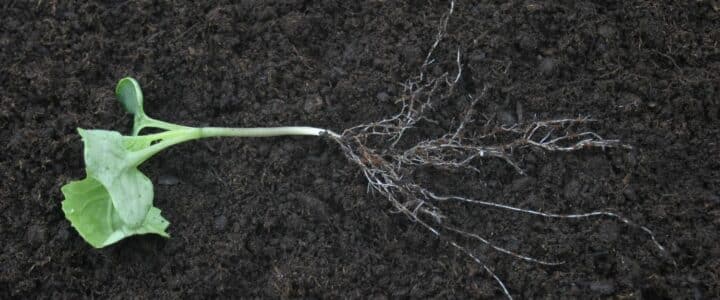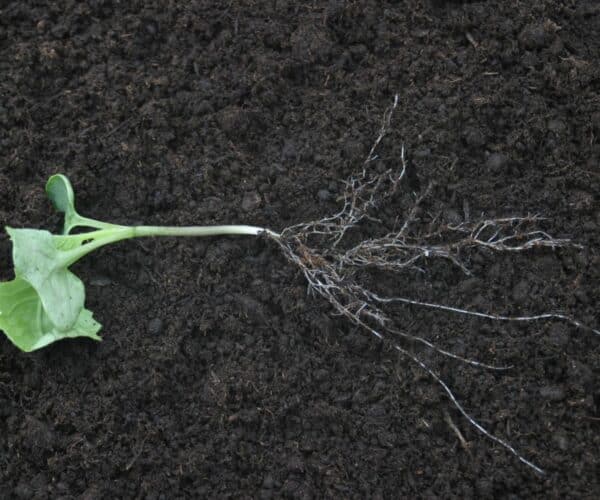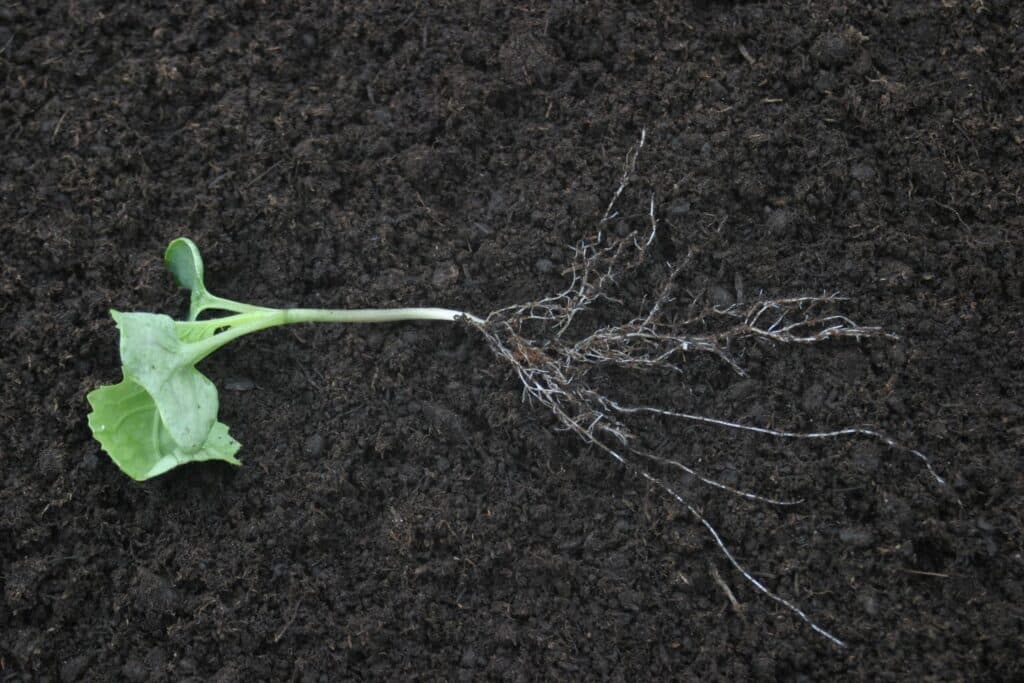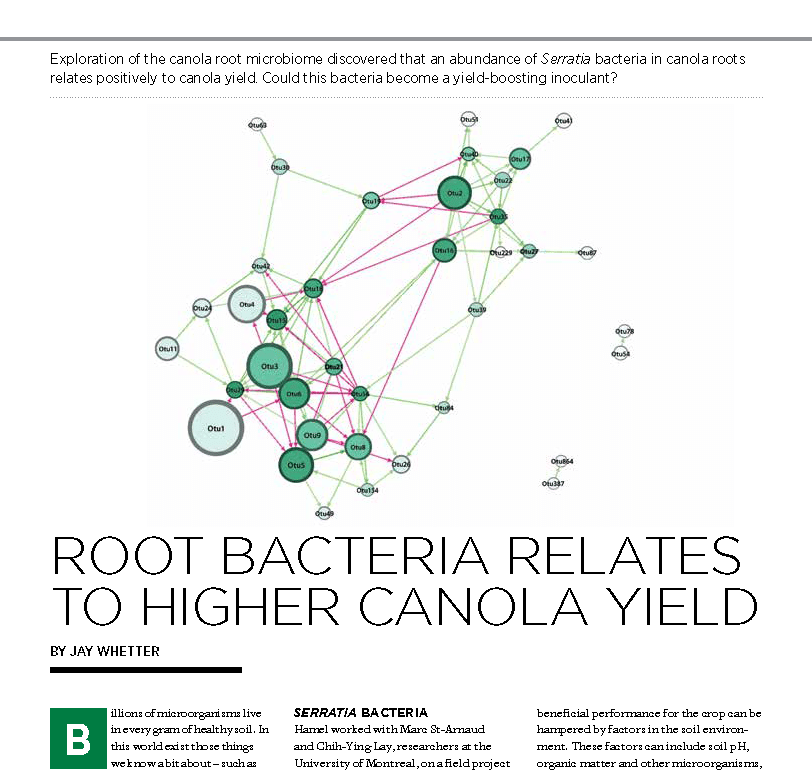
A good seedbed is important for germination and emergence and a plant’s root microbiome may also be important for nutrient cycling and plant growth.
Potential impacts of root-associated microorganisms
Dr. Chantal Hamel was interested in exploring plant root microbiomes because under favourable scenarios microorganisms have potential to improve soil fertility, plant health, the efficiency of fertilizer, and crop productivity, resulting in greater profits. One of these scenarios could be an optimized rotation to maximize beneficial microbiomes. There is also potential to produce inoculants containing beneficial microorganisms adapted to living with roots that could protect crop plants against pathogens, or to biologically fix dinitrogen (N2) into plant available nitrogen.
Greater knowledge of root-associated microorganisms could also improve monitoring the presence or abundance of microorganisms influencing the health, performance, and productivity of plants. This could, in turn, support the development of improved cropping systems, cropping practices, and potentially even better cultivars, which can all support the sustainable intensification of canola production.
Hamel’s ‘Enhancing the beneficial root microbiome in canola‘ project addressed two goals for understanding canola roots microbiota, identifying core microbiome in soil under different crop rotation systems, as well as for the improvement of fertilizer efficiency for canola production:
- To assess the consistency and variability in the composition of the canola core root microbiome, including confirming a list of reliable microbial taxa (i.e. the list of those taxa that are always present and abundant in canola core root microbiome).
- To determine the crop rotation systems best favoring the establishment of a beneficial root microbiome in canola and in other rotation crops.
Hamel’s research team used two field experiments (in Swift Current and Indian Head) to address these goals by accomplishing the following five objectives.
Describing the canola root microbiome
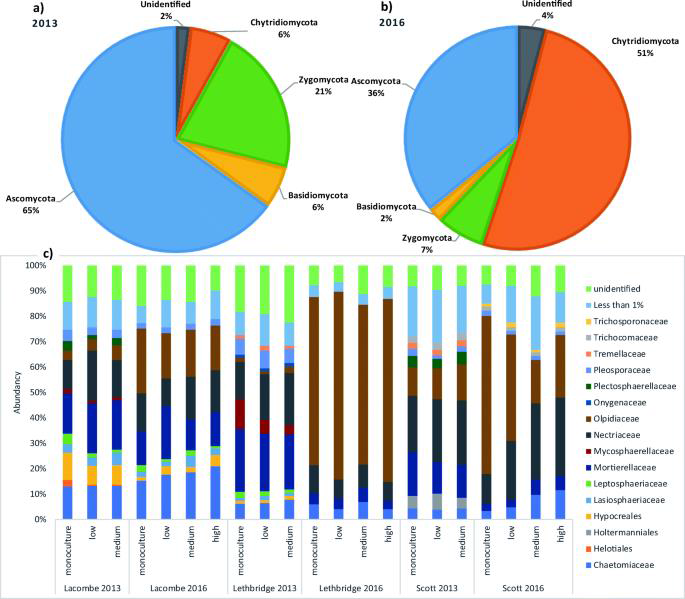
Objective 1: The research team described the canola root microbiome as influenced by different rotation systems and time, on a Brown and a Black chernozem soil.
In accomplishing this, the following outcomes were determined:
- Canola root microbiome and rhizosphere was consistently different from those of wheat and pea.
- These microbiomes contained plant-growth promoting rhizobacteria which positively correlated with canola yield.
- Crop species had a significant influence on bacterial and fungal assemblages, especially within the roots, while higher nutrient input or seeding density did not significantly change the composition of microbes associated with canola roots.
- The results suggest that canola seeding density and plant nutrition management modified the abundance of bacterial and fungal taxa forming the core microbiomes, which could impact crop growth.
- There was relatively less Olpidium brassicae, a known pathogen of members of the Brassicaceae, in canola roots with higher seeding densities.
- The results suggest that canola seeding density and plant nutrition management modified the abundance of bacterial and fungal taxa forming the core microbiomes, which could impact crop growth.
Rotation systems with most efficient nitrogen cycling in the canola rhizosphere
Objectives 2: To identify the rotation systems with the most nitrogen cycling efficiency in the canola rhizosphere by quantifying the expression of genes involved in the processes of biological N2-fixation, nitrification, and denitrification in canola rhizosphere.
Objectives 3: To Identify the root microbiome taxonomic profiles and taxa related to efficient nitrogen use by canola crops.
As noted by Hamel, nitrogen in the air and soil can cycle through eight key inorganic nitrogen species of different oxidation states. The three major biological processes include N2 fixation (N2 reduction to NH4+), nitrification (oxidation of NH4+ to NO, NO2− and NO3−) and denitrification (reduction of NO3− to NO2−, NO and N2). Further details on this complicated cycle is covered in the final report of this Enhancing the beneficial root microbiome in canola study. See the nitrogen cycle infographic (pictured) for additional reference.
A range of microorganisms can impact aspects of this cycle, such as microorganisms involved in oxidizing NO to N2O in the soil and in reducing N2O to N2 (which mitigates the negative impact of denitrification on air quality). In addition, the abundance of microbial nitrogen-cycling genes is different in soil and roots and is affected by the identity of the crop plant. Therefore, nitrogen-cycling gene expression patterns in the root and rhizosphere microbiomes of five oilseed crops (Brassica napus, B. carinata, B. juncea, Sinapis alba and Camelina sativa) in three 2-year crop rotations (which included fallow, lentil or wheat in the non-oilseed year), were investigated in this study.
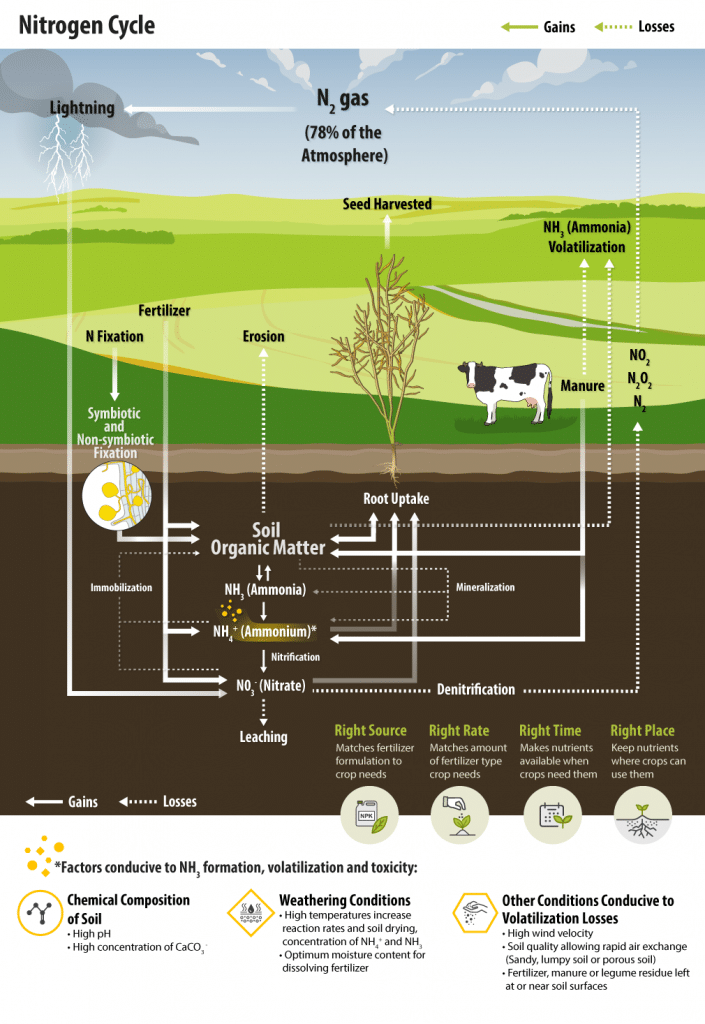
Results from this study indicated:
- The microbiome of Ethiopian mustard (B. carinata) had the lowest potential for nitrogen loss while camelina (C. sativa) had the highest potential for nitrogen loss, based on the nitrogen-cycling gene expression patterns in their microbiomes.
- Brassica carinata showed the best performance with the highest yield and lowest impact on potential greenhouse gas emissions among the five oilseed plants tested in the study.
- Camelina exhibited the opposite trend, with lower yield and higher denitrification potential.
- The preceding crop was also important factor to consider in crop production systems:
- Lentil, as a preceding crop for oilseed production, could help to increase N2 fixation, decrease nitrogen fertilization application and reduce the agricultural footprint on the environment.
- Wheat, as a previous crop for oilseed production, was a poor performer for sustaining oilseed production and could result in nitrogen loss and potentially higher greenhouse gas emissions than a lentil.
- Overall, the findings highlight that diversified pulse oilseed cropping sequences are highly desirable on the semiarid northern Great Plains of North America to achieve high N2 fixation and retention and minimize nitrogen loss in productive cropping systems.
Canola root microbiome potential for tolerance to abiotic stress and pathogen pressure
Objective 4: Evaluate the potential of canola root microbiome to provide canola with tolerance to abiotic stress and pathogen pressure.
The impact of canola-cereals-pea rotation systems (intensifying canola, cereals or pulse over four years) were tested on crop productivity, arbuscular mycorrhizal (AM) fungal diversity and community structure in the roots and in the rhizosphere of each crop, as well as pinpointed relationships between specific AM fungal microbiome members and crop productivity.
Key results from this experiment included:
- Increasing the frequency of canola in a 4-year rotation did not reduce the productivity of other crops in the rotation nor did it reduce biodiversity of AM fungi in the roots or in the rhizosphere of those crops, except for canola itself.
- Conversely, crop and cropping system did modify the AM fungal community structure in both roots and rhizospheric environments of the plants with positive or negative correlations with crop productivity.
- This could imply a simple modification of the cropping system could be used to manipulate root or endophytic microbiomes to improve crop productivity without increasing the amount of input in crop production.
Correlating microbial changes with plant performance and rotational practices
Objective 5: Correlate the changes in microbial compositions with plant performance and rotational practices in order to improve understanding of the interactions between the microbial community and the plants.
Rhizosphere microbes influence one another, forming extremely complex webs of interactions that may determine plant success. Identifying the key factors that structure the fungal microbiome of the plant rhizosphere is a necessary step in optimizing plant production.
Key outcomes from these examinations included:
- Crop diversification had a significant effect on the structure of the rhizosphere fungal community but not on fungal diversity.
- A canola core microbiome and an eco-microbiome was discovered and described along with the identification of five specific highly interrelated components within the microbiome).
- The variability noticed between the microbe components in each year of sampling challenges the concept of a plant core fungal microbiome and its stability.
Conclusions

This ‘Enhancing the beneficial root microbiome in canola‘ project demonstrated that biodiverse agricultural systems improve agricultural productivity and climate management. It was determined that soil history was significant in structuring the bacterial communities when soil chemistry was highly significant (under the environmental conditions during this research). As well, Brassicaceae host plants were consistently significant in structuring the bacterial communities.
It was found that canola microbiomes were different between the root and rhizosphere, and significantly different between those of pea and wheat. Rhizobacteria that were positively correlated with canola yield were identified.
The outcomes contributed to a better understanding of canola microbiota which provides important information to improve canola yields and reduce greenhouse gas emissions by identifying the best rotation system that could potentially reduce nitrogen fertilizer use.
The study also provides the background information about the canola root microbiome that is fundamental for the design of microbiome management strategies to improve canola yield and health.
Further details on this research can be found in these resulting publications:
- Bacterial Communities of the Canola Rhizosphere: Network Analysis Reveals a Core Bacterium Shaping Microbial Interactions
- Inter-Kingdom Networks of Canola Microbiome Reveal Bradyrhizobium as Keystone Species and Underline the Importance of Bulk Soil in Microbial Studies to Enhance Canola Production
- Expression of N-cycling genes of root microbiomes provides insights for sustaining oilseed crop production
Additional root microbiome research
- SaskPulse’s Development of a highly reliable biofertilizer for pulse-based rotations
- See Dr. Gan and Dr. Hamel’s 2017 Pulse and Soybean Agronomy Update presentation (pictured) for related information
- WGRF’s Improving the efficiency of cropping systems through the management of root microbiota in the Canadian Prairies
- Canola frequency effects on nutrient turnover and root-microbe interactions
- Climate change resilience of Prairie oilseed crops and their below-ground microbiota under drought stress in controlled and field environments
- Main factors affecting nutrient and water use efficiencies in spring canola in North America: A review of literature and meta-analysis
- Improving nitrogen use efficiency (NUE) and soil sustainability in canola production across Canada
- Understanding canola root morphology and microbiomes in response to soil phosphorus fertility
Published April 27, 2022


